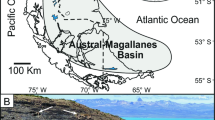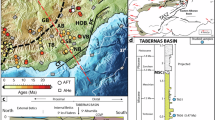Abstract
IN a recent communication1, A. Lamont has directed attention to the application of current-bedding to the determination of the orientation of strata made by John Kelly in 1864. This does not mean, however, that John Kelly was the first geologist to realize the importance of current-bedding, its mode of formation and its relation to the strata. The first, rather crude representation of current-bedding, which I was able to find, was published by MacCulloch in 18192 (vol. 3, pl. 18, Fig. 2). This figure refers to the well-known Scalpa Sandstone of Strathaird in Skye, but MacCulloch's description and explanation of this occurrence (vol. 1, p. 348) are rather inadequate. The first correct interpretation of current-bedding was given by Lyell, who in company with L. A. Necker in 1829 had examined a section at the confluence of Rhone and Arve3,4. Lyell has also described many examples of current-bedding found in strata of different ages, including the Pre-Cambrian5. He was perfectly aware that the truncated parts of the laminæ indicate the upper part of the strata.
This is a preview of subscription content, access via your institution
Access options
Subscribe to this journal
Receive 51 print issues and online access
$199.00 per year
only $3.90 per issue
Buy this article
- Purchase on SpringerLink
- Instant access to full article PDF
Prices may be subject to local taxes which are calculated during checkout
Similar content being viewed by others
References
NATURE, 145, 1016 (1940).
MacCulloch, J., "A Description of the Western Islands of Scotland, etc.", London (1819).
Lyell, Ch., "Principles of Geology, etc.", London, vol. 1, p. 254, Fig. 6 (1830).
Ibid., vol. 1, p. 378, Fig. 13 (1837).
Ibid., vol. 4, pp. 78–81, 361–363 (1837).
Author information
Authors and Affiliations
Rights and permissions
About this article
Cite this article
TOMKEIEFF, S. First Use of Current-Bedding to Determine Orientation of Strata. Nature 146, 369 (1940). https://doi.org/10.1038/146369b0
Issue date:
DOI: https://doi.org/10.1038/146369b0



